Art’s not just decoration—it’s a little window into who you are. The pieces you hang up at home show your tastes, values, and honestly, how you see the world.
Remember to repin your favorite images!
When you pick artwork that really reflects your personality, your rooms start to feel like you, not just some catalog.
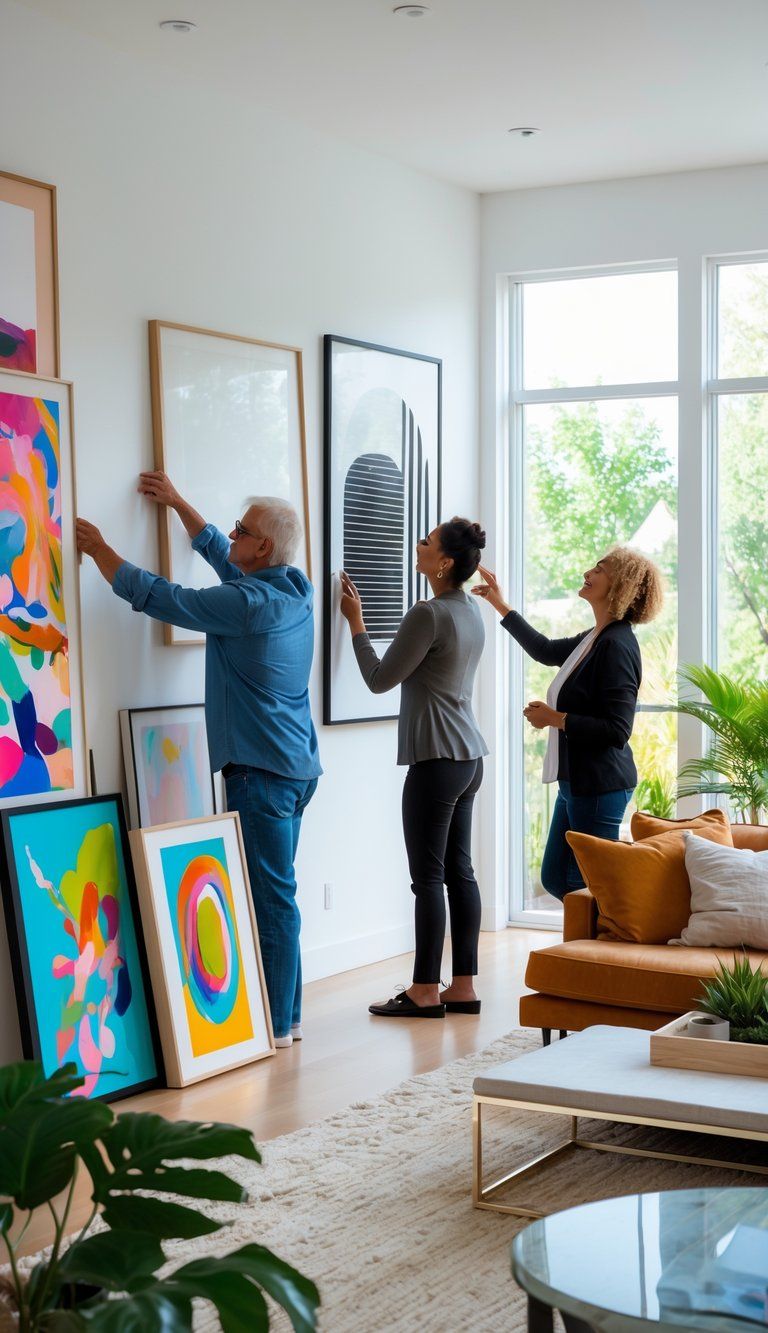
When you walk into a room filled with art you love, it just feels different. There’s this sense of comfort and connection that generic decor can’t give you.
Some folks gravitate toward bold abstracts that show off creativity. Others lean into serene landscapes for a bit of calm.
Your art choices might highlight travel memories or family bonds, or just stuff you’re passionate about.
Finding the right pieces means knowing what colors speak to you and what emotions you want in your space. You might go for a dramatic canvas as a bold focal point, or maybe you prefer a cozy gallery wall of smaller works.
Whatever you choose, it should feel right to you—even if it’s not what’s trending.
Understanding the Connection Between Art and Personality
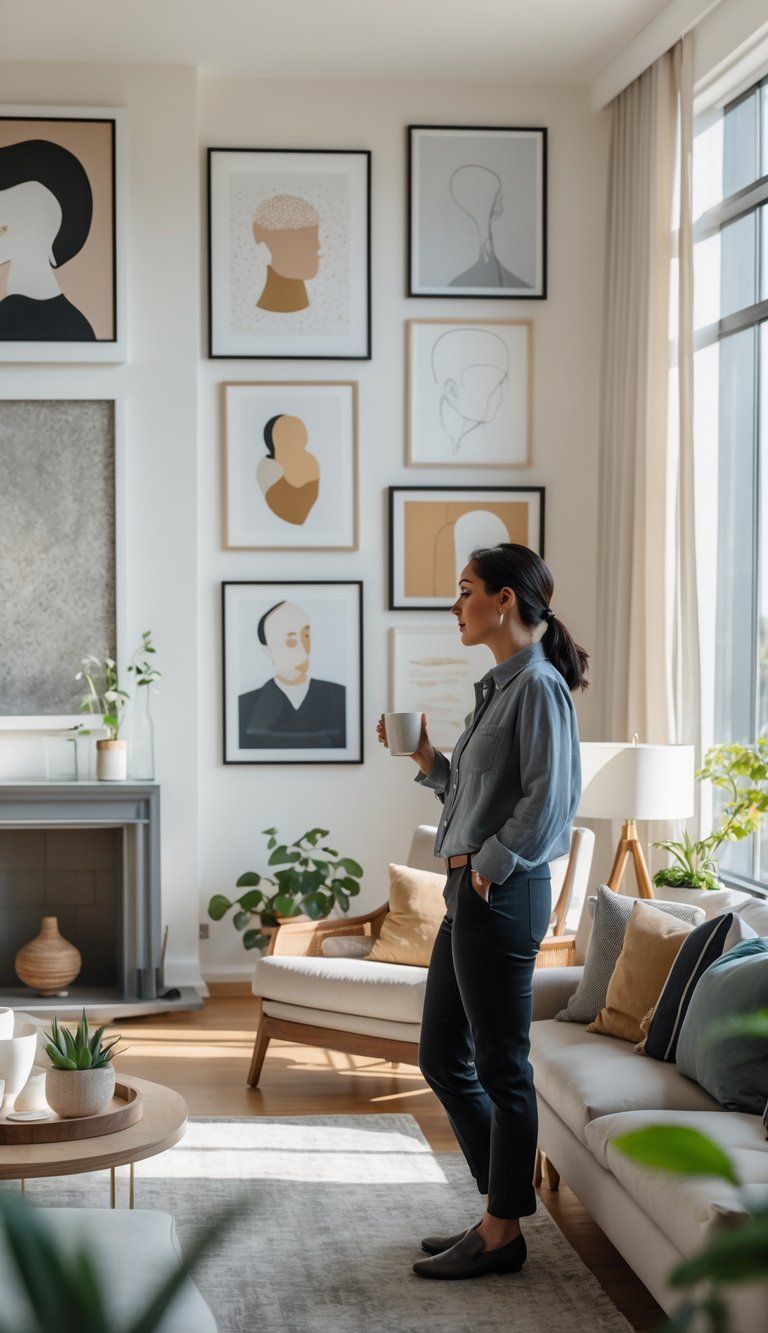
Art choices say a lot about us. The pieces we put up at home act as visual representations of our inner selves.
They connect our experiences with creative expression.
How Art Reflects Your Personality
The art you’re drawn to usually mirrors your personality. Bold, vibrant abstracts? Maybe you’re outgoing and expressive.
Calm landscapes? You might be a bit more contemplative.
Researchers say extroverts often go for art with warm colors and dynamic vibes. Introverts seem to like cooler tones and detailed, intricate works.
Your life experiences shape your taste, too. If you grew up by the ocean, you probably feel a pull toward seascapes or nautical stuff.
Art can show off your values. If you pick pieces with environmental themes, it might mean sustainability matters to you.
The Role of Emotion and Mood in Art Selection
Art triggers emotional responses that can totally change a room’s vibe.
Different pieces set different moods.
Mood influence:
- Calming blues and greens → peaceful vibes
- Vibrant reds and oranges → energetic spaces
- Monochromatic palettes → sophisticated, focused areas
A lot of folks pick art based on how they want to feel in a room. A chill painting in the bedroom helps you relax, while dynamic artwork in the office might fire up your creativity.
Your emotional connection to art can shift. What resonated with you a few years ago might not hit the same now.
Expressing Your Unique Taste Through Art
Art is such a fun way to show off your style. It brings personality to your space—way more than mass-produced stuff ever could.
Mix up styles, periods, and mediums until your collection feels like you. Forget the design rules for a sec—trust your gut.
Start with one piece that really feels like you and build from there.
Personal connections make art special. A painting from a trip, a photo that brings back memories, or a piece by an artist you admire will always mean more than something you picked just to match the sofa.
Identifying Your Personal Style and Preferences

Finding art that feels right starts with knowing your own style. Your favorite colors, subjects, and artistic styles can say a lot about who you are.
That helps you pick pieces you’ll actually love for years.
Exploring Your Personal Aesthetic
Start by noticing what catches your eye. When you’re at a museum, scrolling online, or flipping through a mag, which images make you stop?
Look for patterns in what you like. Do you gravitate toward bold, punchy colors or softer, muted tones?
Are you into realistic portraits or wild abstracts? Maybe landscape photography grabs you more than oil paintings.
Quick Exercise to Find Your Aesthetic:
- Save 20-30 images of artwork you love
- Look for common threads—colors, subjects, styles
- Pay attention to how different pieces make you feel
Go with your gut. Art that stirs up real emotion—calm, excitement, nostalgia, inspiration—is usually a good fit for your personal style.
Incorporating Interests and Preferences
Your hobbies and passions can guide your art picks and make your space feel more personal.
If you’re a traveler, maybe you’ll go for maps, cityscapes, or landscapes from favorite places. Nature lovers might like botanical prints or wildlife photos.
Bookworms could hang up typographic art with favorite quotes.
Think about what makes you happy every day:
- Love cooking? Vintage food ads are fun.
- Into music? Concert posters or abstract art inspired by sound could work.
- Sports fan? Action shots or old-school memorabilia might hit the spot.
The best art connects to your life and what matters to you. Don’t stress about what’s trendy—choose what feels like you.
Recognizing Influences from Interior Design
Your current decor can give clues about your style. Check out your furniture, colors, and overall vibe.
If your space is minimalist with neutral colors, you might want simple geometric art or black and white photos.
Vintage furniture? Maybe traditional oil paintings or retro prints fit better.
Think about your home’s architecture, too. Modern buildings often look great with contemporary art, while older homes might suit more classic pieces.
Style Compatibility Chart:
| Your Interior Style | Art Styles to Consider |
|---|---|
| Minimalist | Abstract, monochromatic, photography |
| Bohemian | Folk art, textiles, nature-inspired |
| Industrial | Urban scenes, metal art, blueprints |
| Traditional | Landscapes, portraits, classic prints |
Sometimes, contrast just works. A bold abstract in a classic room can be a total showstopper.
Types of Art That Speaks to You
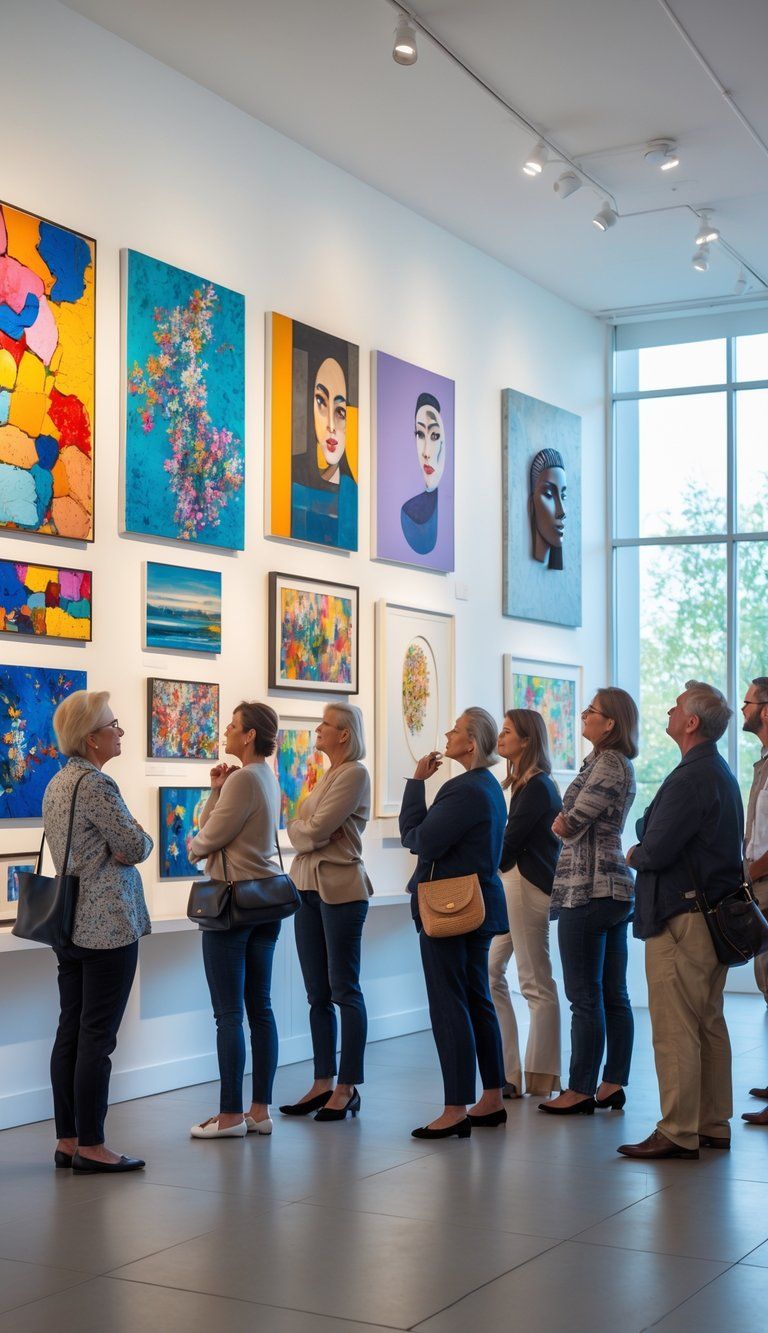
Finding art that clicks with your personality means trying out different styles and mediums.
The right piece can say a lot about you—without you having to say anything at all.
Paintings and Their Impact
Paintings can reveal tons about your personality. If you love traditional art (think Rembrandt or Da Vinci), you probably value history and craftsmanship.
Detail-oriented folks tend to appreciate things that last.
If abstracts or modern paintings catch your eye, you might be open to new ideas and complexity. These works let you interpret things your own way.
Pop art fans usually have a playful streak and love cultural references. If you go for bold, bright images, you probably don’t take life too seriously.
Even the size of the paintings matters. Big, statement pieces? That shows confidence. Smaller works? Maybe you prefer subtlety and intimacy.
Photography as Self-Expression
Photography gives you a way to show how you see the world. If you love street photography, you’re probably observant and appreciate real, human moments.
Nature photography fans often crave peace and beauty. If that’s you, you probably like a little serenity in your life.
Portrait fans usually care about storytelling and human connection. You might be fascinated by people’s stories and emotions.
Black and white photography? That’s for folks who love simplicity and contrast. Maybe you like finding meaning in the basics.
The subjects you’re drawn to—cityscapes, close-up portraits, or abstract shots—reflect what matters to you.
Exploring Sculptures and Mixed Media
Three-dimensional art speaks to people who like to think outside the box. If sculptures grab your attention, you probably appreciate texture and physical form.
Metal sculptures might appeal to you if you value strength and permanence. Clay or wood pieces feel right if you love natural materials.
Mixed media art, with all its different materials, tends to attract adaptable, creative types. If you like breaking the rules, this might be your thing.
Installation art fans usually want immersive experiences and deep ideas. If you like to really engage with art, not just look at it, you’ll probably love this style.
Even with sculpture, size says something. Monumental pieces are for the bold, while tiny, detailed works attract those who love precision.
Matching Art with the Mood and Atmosphere of Your Space
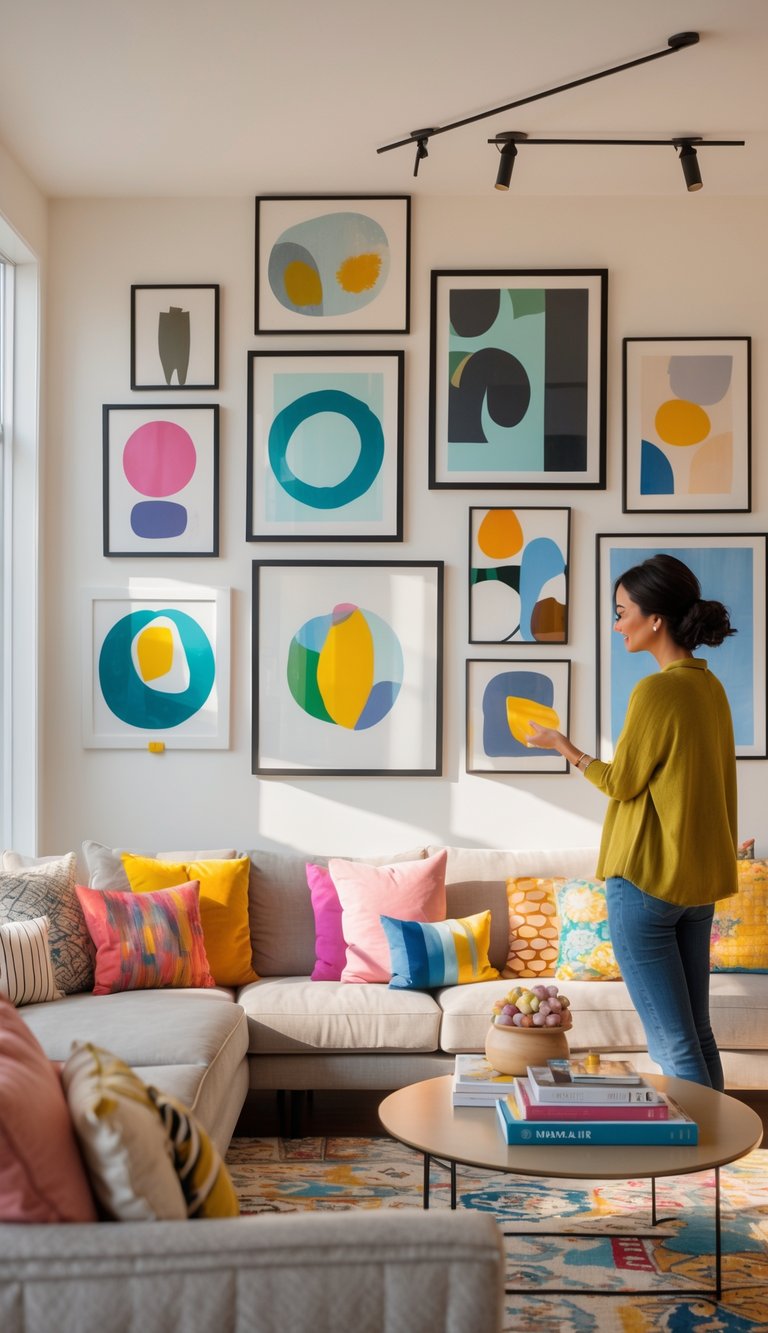
The art you pick sets the tone for a room. Choosing pieces that fit the mood you want can turn a plain space into your own personal haven.
Choosing Tranquil or Energetic Pieces
Tranquil spaces work well with art that’s soft, flowing, and peaceful. Nature scenes, cool-toned abstracts, or minimalist pieces can make bedrooms and reading nooks feel calm.
For energetic rooms like offices or dining areas, go for bold colors, dynamic shapes, or textured art. Cityscapes, lively abstracts, or pop art spark conversation and creativity.
Think about what you do in each room. Relaxation spots need soothing visuals, while busy spaces benefit from more stimulating art.
Let the art’s energy match your mood. A gentle landscape helps you unwind, while a punchy abstract can kickstart your day.
Using Color Palette and Color Scheme Effectively
Pick art colors that work with your decor and set the right mood. For a pulled-together look, echo colors from your furniture or accents in your art.
Cool shades (blues, greens, purples) make rooms feel calm—great for bedrooms or bathrooms. Warm colors (reds, oranges, yellows) bring excitement, perfect for living or creative spaces.
Try these color ideas:
- Monochromatic: Use shades of one color for a subtle, sophisticated feel
- Complementary: Opposite colors for bold contrast
- Analogous: Neighboring colors for a smooth, harmonious vibe
Don’t forget about size and placement. A big, colorful piece can anchor a neutral room, while smaller pops of color add interest without taking over.
Selecting Statement Pieces for Focal Points
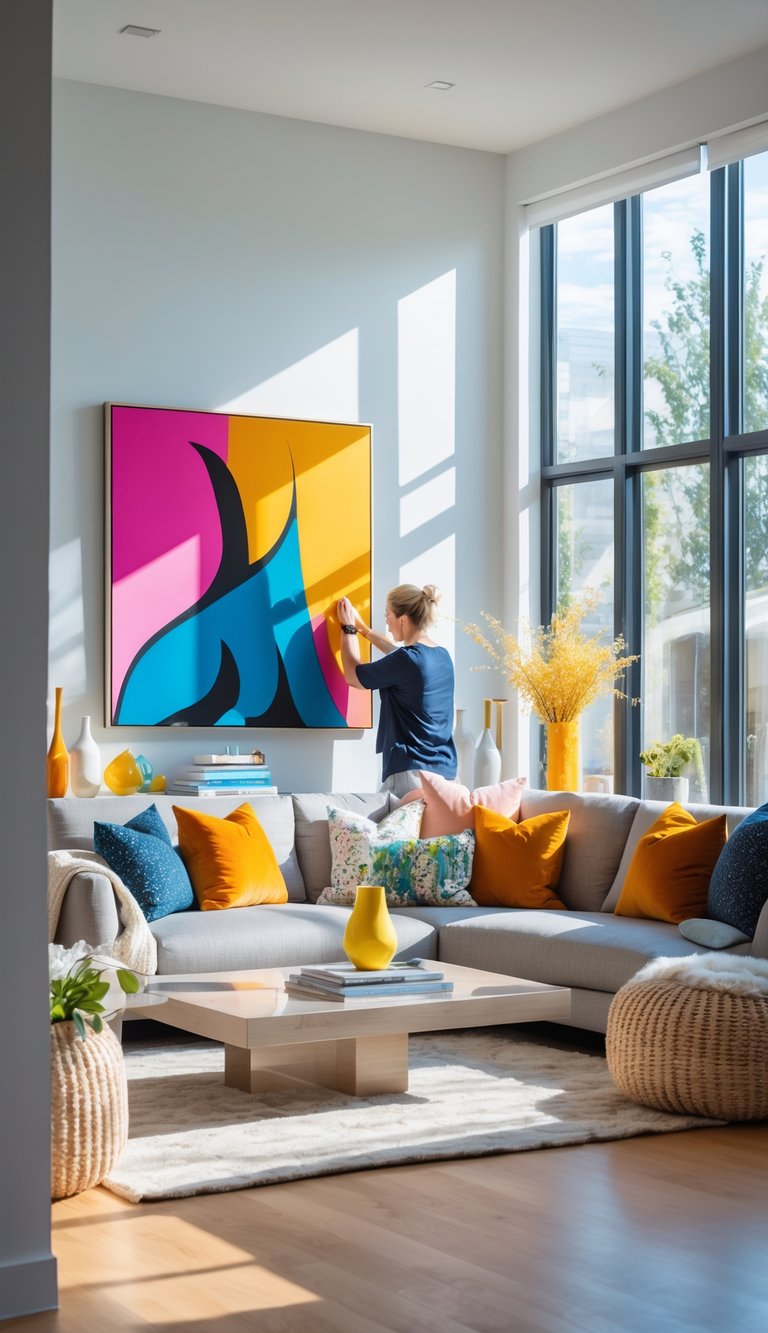
Statement pieces take a room from “nice” to “wow.” They grab attention and show off your personality—loud and clear.
Finding Your Statement Piece
Ask yourself what really resonates. Look for art that makes you feel—whether it’s excitement, calm, or even a bit of wonder.
The best statement pieces tell a story or connect to your values.
When you’re shopping, trust your first reaction. If something makes you stop and stare, that’s a good sign.
Try these for big impact:
- Oversized canvas paintings that dominate the space
- Sculptural elements for some depth and texture
- Vintage finds that come with a bit of history
- Bold photography that captures a moment
Size matters with focal points. Too small and it disappears; too big and it overpowers. Measure your wall and leave a little breathing room—6 to 8 inches usually does the trick.
Balancing Statement Art with Other Decor
After you find your perfect statement piece, start building your room around it. Try pulling colors from the artwork for smaller accessories—pillows, vases, maybe even a throw blanket—to tie everything together.
If your focal point is bold, keep the surrounding decor simple. When you have artwork with vibrant colors, neutral furniture helps balance things out. This way, your eye knows where to look first.
Here are a few practical tips:
- Hang your statement piece at eye level in the most visible spot.
- Use lighting that really highlights your focal point.
- Avoid too many competing patterns or bold colors nearby.
- Leave some negative space around your art so it can “breathe.”
Balance doesn’t always mean symmetry. Sometimes, placing art off-center creates interesting tension and still keeps the room feeling harmonious.
Scale, Placement, and Mixing Art Styles
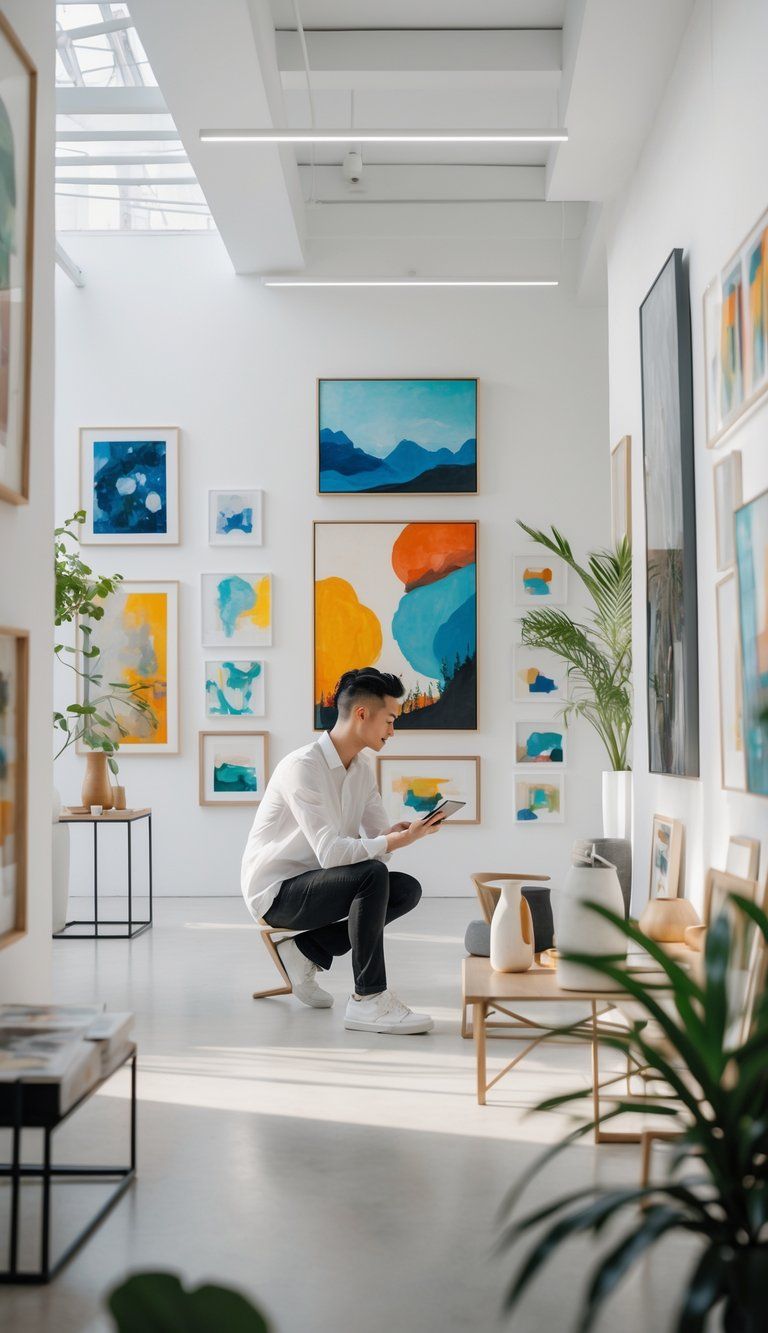
When you want your art display to stand out, pay attention to size, placement, and style combos. The right approach can really transform your walls.
Understanding Scale and Placement
Match the size of your artwork to your wall. A tiny piece on a big wall just gets lost, while a huge piece in a small space feels like too much.
For big walls, you’ve got options:
- One large statement piece (covering about two-thirds of the wall width)
- A gallery wall with several pieces
- A diptych or triptych (sets of two or three related artworks)
Hang art at eye level—usually 57 to 60 inches from the floor to the center. That’s where most people naturally look.
If you’re hanging art above furniture, leave 6 to 8 inches between the furniture and the bottom of the frame. This gives a nice visual connection without making things feel crowded.
Mix and Match: Blending Art Styles
You don’t have to stick to one style. The 70-20-10 rule works: 70% one main style, 20% a secondary style, and 10% as an accent.
What mixes well?
- Paintings, photos, and prints together
- Modern art with vintage pieces
- Contrasting colors that still fit your room’s palette
Pick a unifying element. Maybe it’s the frame style, a color theme, or a subject matter that pulls everything together.
If you’ve got a lot of busy, colorful pieces, add a few simpler works to give your eyes a break.
Creating a Personal Touch with Unique Pieces
Let your art collection tell your story. Pick pieces that reflect your experiences, interests, or values.
Try these personal touches:
- Family photographs in matching frames
- Travel souvenirs or local art from your trips
- Handmade items from you or people you care about
- Commissioned pieces that fit your taste
Switch out your collection from time to time—maybe seasonally—to keep things feeling fresh. This way, you can enjoy more of your art and avoid getting bored.
Take your time building your collection. Finding meaningful art is a process, and it pays off way more than just grabbing something generic to fill space.
Incorporating Nature and Urban Elements
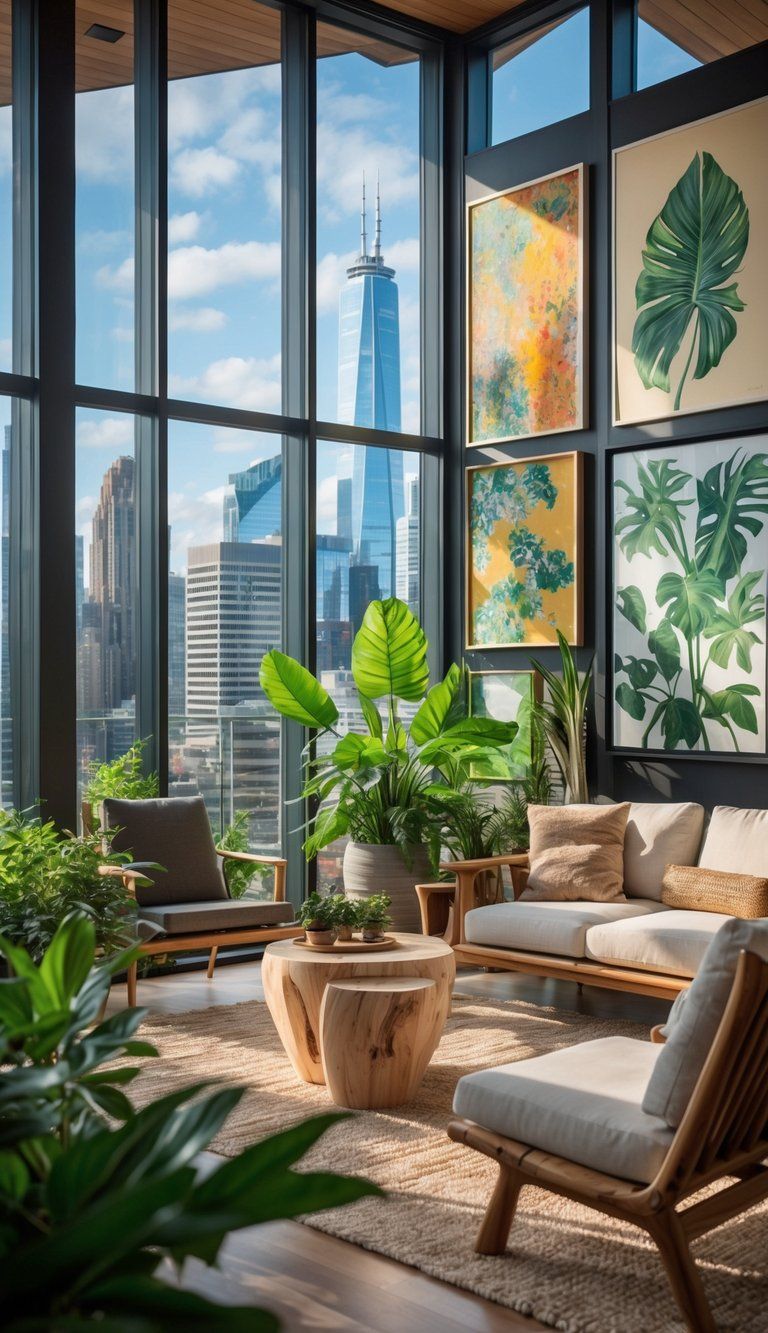
Bringing nature or city vibes into your home through art helps you feel connected to the places you love. These choices can turn your place into a personal sanctuary that really feels like you.
The Influence of Calming Landscapes
Nature art sets a peaceful tone in any room. Landscapes—mountains, forests, beaches—can help lower stress and make your space feel relaxing.
Think about the colors you see in your favorite outdoor spots. Soft blues and greens from ocean scenes feel calm, while autumn colors add warmth.
Nature art ideas:
- Watercolor landscapes
- Botanical prints
- National park photography
- Abstract takes on nature
- Textured forest or mountain paintings
Size matters here too. A big landscape can act like a window to the outdoors, while smaller pieces create cozy moments around your home.
Urban Landscapes as Art
Urban art brings city energy indoors. Cityscape photos, architectural sketches, or street art can give your space a cool, modern edge.
Black and white city photos have a timeless vibe. Colorful cityscapes can show off the energy you love about urban life.
Try these urban elements:
- Skyline silhouettes
- Street photography
- Abstract city grids
- Architectural details
- Night scenes with city lights
Urban art fits especially well in home offices, dining areas, or modern living rooms. The geometric lines work great with clean, contemporary furniture.
Mixing urban and nature pieces can create nice balance—maybe a bold city scene paired with smaller, soothing nature prints.
Exploring Current Art Trends and Sources
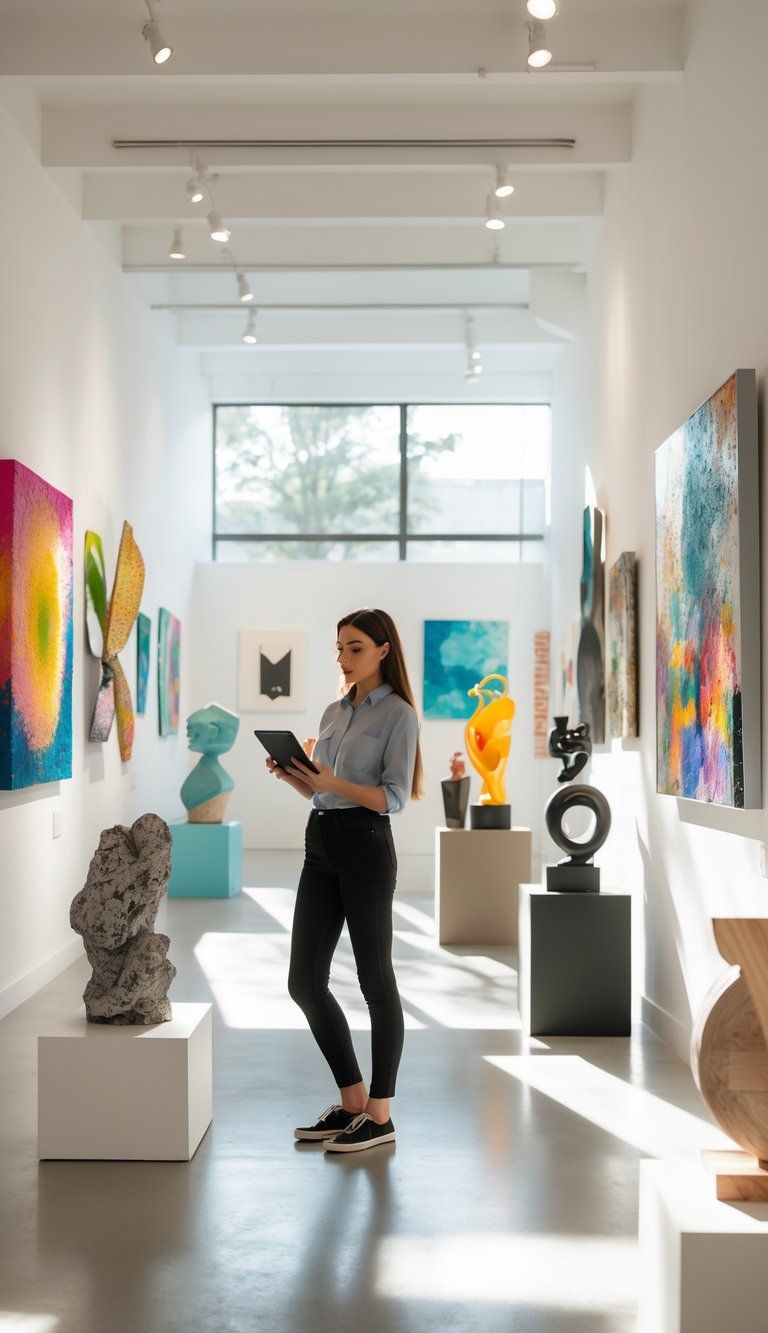
Keeping up with art trends can help you find pieces that really fit your vibe. Art communities, galleries, and online platforms all offer different ways to discover artwork that clicks with you.
Discovering Trends in Art Communities
Art communities are goldmines for spotting emerging trends before they hit the mainstream. Social media—Instagram, Pinterest—makes it easy to see what’s hot right now. For 2025, you’ll see grounding earth tones, mindful maximalism, and bold illustrations popping up everywhere.
Follow hashtags like #ArtTrends2025 or join online groups where people talk about new styles. Local art clubs and community centers sometimes host talks about current artistic directions.
Museums also give you a peek at which old styles are inspiring artists today. Take notes during exhibitions if you see something that grabs you.
Sourcing Art from Galleries and Fairs
Galleries let you see art in person—so important for getting a feel for real colors and textures. Staff can share background info about artists and techniques, which helps you make better choices.
Art fairs bring lots of galleries together, so you get a wide selection in one place. Big fairs like Art Basel show off international talent, while local fairs highlight regional artists and sometimes better prices.
2025 Notable Art Fairs:
- Spring Art Collective (March)
- Summer Gallery Exchange (July)
- Autumn Emerging Artists Fair (October)
Don’t worry if you’re new to galleries. Most owners love talking about art, no matter your experience or budget.
Choosing Art Online and through Commissions
Online galleries have made art collecting way more accessible. Sites like Artfully Walls and iCanvas let you search by style, color, or size—super handy.
When you shop online, check:
- Return policies
- Image quality
- Artist background
- Sizing info
Commissioning art makes things personal. Work with artists whose style you like, but be clear about what you want—while still giving them creative freedom.
Art prints are a wallet-friendly option. Good reproductions can capture the feel of original works for a lot less.
Practical Tips for the Art Selection Process
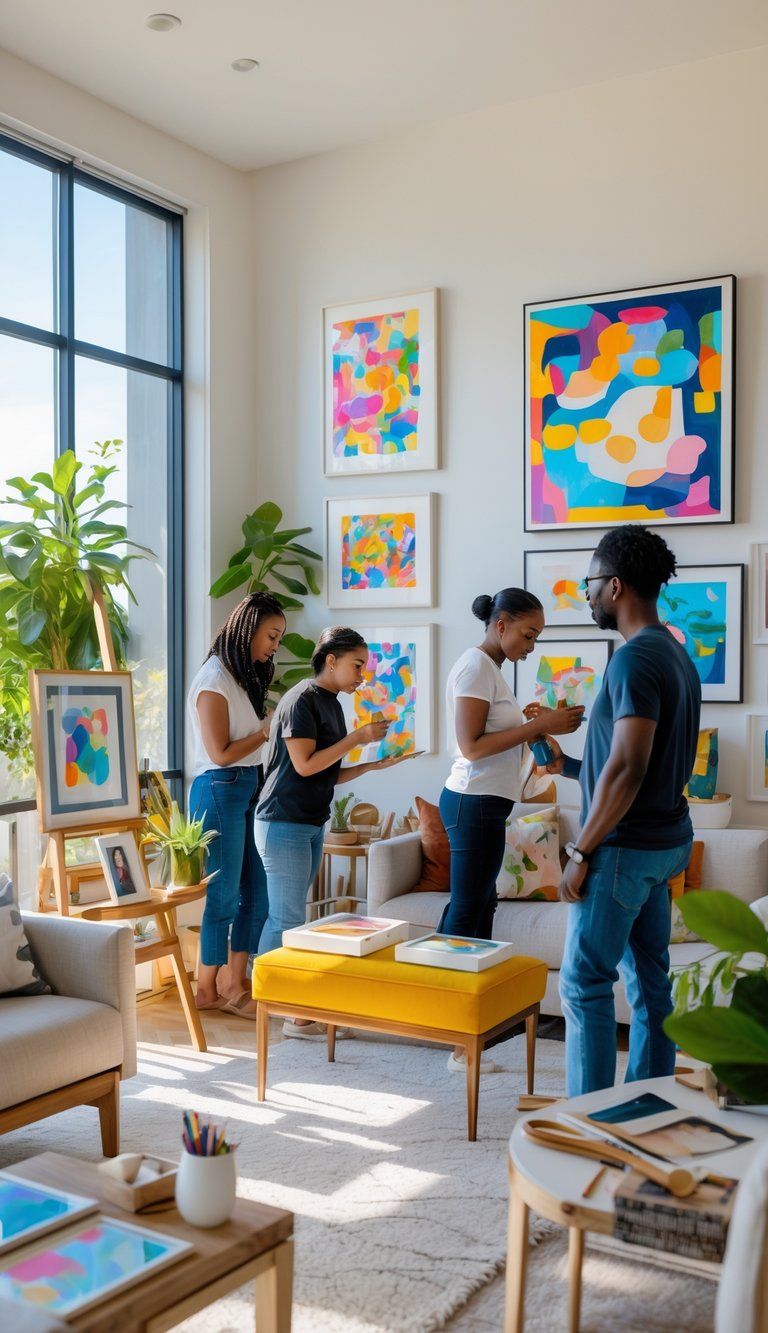
Finding art that really feels like you takes a little planning. The right process helps you discover pieces that not only make your space look better but also connect with you.
Defining Your Art Selection Criteria
Start with a simple list of what matters to you in art. Think about colors that make you happy or themes that interest you. Do you prefer abstract shapes or realistic images? Nature scenes or cityscapes?
Consider the practical stuff too:
- Size and scale: Measure your wall space before you shop.
- Budget: Know what you’re comfortable spending.
- Medium: Decide if you want paintings, prints, photos, or mixed media.
Your home’s style matters. Modern minimalist spaces often look great with bold, simple pieces. Traditional homes might call for more classic art.
Take photos of your rooms to reference while you shop. It’s easier to imagine new art fitting in when you have those handy.
Ensuring Personal Connection to Chosen Pieces
The way art makes you feel? That’s really what matters most. When you look at something, just notice your first gut reaction.
Does it stir up any emotion? Maybe it reminds you of a memory or something close to your heart.
You’ll usually connect more with art that lines up with your interests or your own life. If hiking is your thing, maybe grab a landscape from a place you’ve trekked.
Music lovers might want something that pulses with that same energy.
Before you buy, ask yourself a few things:
- Does this piece make me smile or spark some kind of feeling?
- Can I see myself loving this art years from now?
- Does it tell a story that actually means something to me?
Take your time. Let the idea of that piece sit with you for a few days before you jump in.
The right art isn’t just for filling up wall space—it’s something that weaves into your own story.

